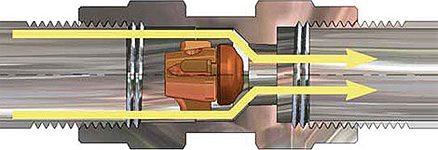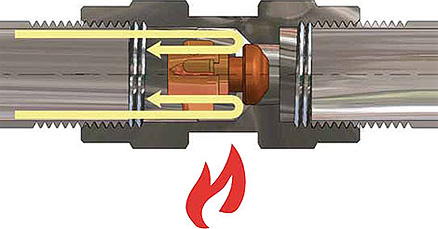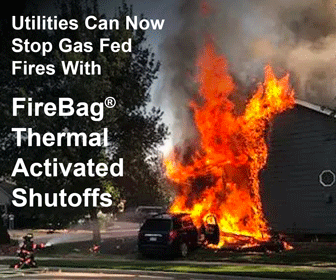How the FireBag® Works
Keeping homes and communities safe
Homeowners can easily improve the safety of their gas-powered homes and appliances with little expense and trouble. United States homeowners can now enjoy an added level of safety that homes throughout the world have long adopted. FireBags installed at all gas appliances, and at the gas meter itself, prevent gas leaks in fire situations, thereby preventing the spread of fire.
The FireBag thermal shutoff off consists of a zinc-plated steel pipe that contains a small device that responds to high temperatures. This device contains a plug, a spring, and a fusible metal alloy. When the ambient temperature near the FireBag reaches a trigger temperature of 203˚-212˚F, the fusible metal alloy melts, releasing the plug, and thereby shutting the flow of gas through the steel line.
This sturdy small mechanism can withstand 1,697˚F for 60 minutes, giving time for first responders to reach the home and turn the gas supply off from the curb.

Cross-section of FireBag
under normal operating conditions

Cross-section of the FireBag when exposed to 203˚-212˚F
and triggered to a closed position
Since the FireBag is a passive device and only triggers in a fire situation, it is virtually maintenance free. No regular inspections are required.
The FireBag protects homes supplied with natural gas from their gas utility, as well as homes that use propane gas tanks or butane. Gas utilities may install a FireBag at the meter to shut off gas supply to the entire house. And homeowners can install FireBags at any gas appliance, such as a gas range and oven, furnace, water heater, gas generator, and gas grills.
When installing the FireBag in a residential setting, the plumber installs the FireBag upstream of existing valves, complying with the directional flow of gas. The FireBag’s installation kit includes seals and rods suitable for high temperatures. FireBags can also be purchased and installed as a unit with an AGA ANSI Z21.15-CGA 9.1-M97 rated ball valve that meets ICC building code requirements.
Commercially, FireBags protect commercial kitchens from gas fires generated at the gas range. They are also used on industrial installations with hot air generators, and with varnishing booths.
The ½” FireBag is the most common size when used to protect home gas appliances. Industrial applications may use larger piping, and have the option of selecting FireBags sized to their piping requirements, including ¾”, 1”, 1 ¼”, 1 ½”, 2” NPT threaded fittings. Additional blank fittings are available to accommodate mixed sizing for ½” x 3/4” fittings.
More information on the fire safety standards used throughout the world that the FireBag complies with is available at http://tecoamericas.com . Specific application uses of the FireBag for homes and industry are also described in more detail on the website.
Resources
Contact Us Today!
All information is confidential and sent directly to a TECO Americas representative.
TECO® Americas, LLC
263 Cox Street Roselle, NJ 07203
inquiry@tecoamericas.com
Phone: 908-488-0909
https://tecoamericas.com


